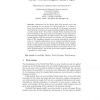38 search results - page 3 / 8 » On-demand new word learning using world wide web |
IJCIS
2000
13 years 5 months ago
2000
Ontobroker applies Artificial Intelligence techniques to improve access to heterogeneous, distributed and semistructured information sources as they are presented in the World Wid...
CHI
2005
ACM
14 years 6 months ago
2005
ACM
From pre-schools to high schools, at home and in museums, the educational community has embraced the use of computers as a teaching tool. Yet many institutions will simply install...
MTA
2008
13 years 5 months ago
2008
Information on the World Wide Web becomes more and more important for our society. For blind people this is a chance to access more information for their everyday life. In this pap...
CORR
2002
Springer
13 years 5 months ago
2002
Springer
The first morphological learner based upon the theory of Whole Word Morphology (Ford et al., 1997) is outlined, and preliminary evaluation results are presented. The program, Whol...
MOBILITY
2009
ACM
13 years 10 months ago
2009
ACM
The convergence of desktop, mobile and web application development has resulted in new types of software systems. These new systems are built to leverage the World Wide Web, and t...

